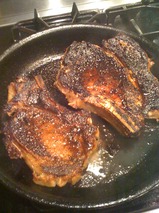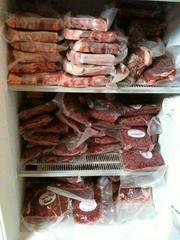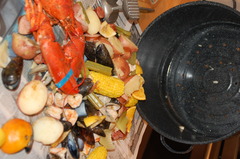Most people never think of their food in lots. We have learned, with the rise of the warehouse store concept (Costco, Sam's) to buy in bulk, and usually dry goods or items that are still individually identifiable, but packed in larger quantities.
Meats are still packaged for small consumption, if just for a few days' more. A package of beef, instead of 1lb, is 10lbs. Easy to get rid of for any party or catering event, or even just two to three family meals. There's little fear there that the food will get used, or that the food will go bad while being consumed. It's easily managed by breaking into two packages, putting into the house freezer, or using it up in a large meal or three.

Committing to a carcass of an animal engenders more fear - an entire cow!? Where do you get it? What will you do with it? Where does it go? At the end of the day, the worry may be 'where do I put it before it goes bad and I waste a ton of money'?
That anxiety is understandable, but it's key to remember -
1) In year's time, if you are a beef-eater, how much beef do you eat? In six months? You may be surprised.
2) Beef costs in 2010. The
Beef Retail Marketing organization's average
wholesale cost of beef (per lb) for the last week of 2010 tells a costly picture (2010 vs 2009) -
- bone-in ribeye - $4.43 / 3.64
- boneless ribeye - $4.86 / 4.29
- tenderloin (muscle on) - $8.37 / 7.83
- strip loin (boneless) - $3.97 / 3.92
- strip loin (bone in ) - $3.32 / 3.19
- top round - $2.05 / $1.69
- brisket, inside skirt - $2.77 / $2.20
- brisket, outside skirt - $3.12 / $2.25
- various fat content/coarse ground chucks/beef - range $1.66 to $2.32 / $1.40 to $2.08
Those are average prices for wholesale, not the retail prices you pay at the counter, repackaged into household individual servings. Suffice to say, the markup once it's a packaged single ribeye $12.99-$15.99 /lb, from your local upscale grocery store.
3) Our household dietary needs demand regular protein - my own consumption should be 100g/day, however, I'd like to be at 120g/day. That's a lot of protein. Now granted, fish, milk, eggs absolutely contribute to this. But making it affordable, convenient, good quality protein at my fingertips is a solid win towards my health. Here's a note from
Beef Issues Quarterly (BIQ) (isn't that awesome), Dec 2010, commenting on the 2010 Dietary Guidelines Advisory Committee's recommendations about plant-based diets and nutrition that would become part of the 2011 government-issued nutrition guidelines (we're overweight, but undernourished). Think the DGAC is encouraging plant-based diets (instead of just lean protein in diets), and BIQ (heh) had something to offer in rebuttal -
While beef contributes only 5 percent of the total calories and 8
percent of the total fat to the American food supply, it provides 29
percent of vitamin B12, 20 percent of the zinc, 14 percent of the
protein, 13 percent of the vitamin B6, 9 percent of the phosphorous, 8
percent of the niacin, 7 percent of the potassium, 7 percent of the iron
and 5 percent of the riboflavin. According to a 2005 analysis of NHANES
data, beef eaters are more likely to meet nutrient requirements for
protein (11%), vitamin B12 (24%), iron (13%) and zinc (26%) than
non-beef eaters.
and
There is a need and an opportunity for the beef industry to take an
active role in educating consumers, as well as food, nutrition and
culinary thought-leaders, about lean beef's nutrient advantage in a diet
that is also balanced with fruits, vegetables, whole grains and low-fat
dairy.
Understandable their concern. They promote beef. But their point is well-taken - and from my own dietary standpoint, that's the key reason for such a protein-heavy diet - while I love grains and fruit, some nutrition is chock-full in protein sources, and if there's a choice to be made on what to ingest, protein wins here as first option, every time.
But I digress -

The average price range for a carcass, during our research, was anywhere from $2.50 - $4/lb, cut and packaged. Now while these were soft numbers, it was clear to us that we were in the right zone for it to be cost effective, considering the amount of beef that we consume in a year and
the retail price we were paying at the store registers and restaurants. Between ribeyes, ground beef, burger places (love you,
Hut's), dining out at steakhouses, seafood joints, or scarfing meat at the local churrascaria (love you,
Estancia), could we safely say that we ate more than the US average of 100 lbs a year, per person.
The most complex thing about the choice to find a healthy, tender animal from a reputable source are the logistics. We're fortunate to have friends in the industry (it is Texas, you know), so it was easy to discuss this option with them, and get their impressions. As it's something they live with daily, it was great validation that purchasing a carcass was a cost-effective and high-quality route. In fact, as things go with friends-of-friends, there is a desire to ensure the best quality available (to keep the wheels of reciprocity spinning happily).
Timing, costs, cuts, processing, packaging, age, live weight, yield - all of these were considerations. More on that later.



